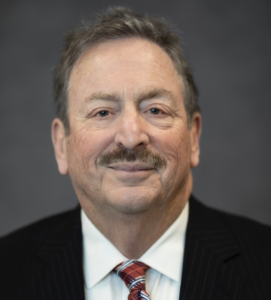As part of CEO Insights series, the Chief Executives Council recently interviewed Mark Gabriel, President and CEO of United Power, Colorado’s largest cooperative by load, and one of the fastest growing cooperatives in the nation. Under his leadership, United Power has recognized as the 31st cooperative to reach a hundred thousand meters served, interconnected its 10000th rooftop solar system, and been named as Solar and Storage Champion by the Colorado Solar and Storage Association.
Power, Colorado’s largest cooperative by load, and one of the fastest growing cooperatives in the nation. Under his leadership, United Power has recognized as the 31st cooperative to reach a hundred thousand meters served, interconnected its 10000th rooftop solar system, and been named as Solar and Storage Champion by the Colorado Solar and Storage Association.
Mark is the current chair of the GridWise Alliance Board of Directors. Prior to joining United Power, Mark served as the Administrator and CEO of the Western Area Power Administration and managed a nonprofit federal organization in marketing and delivering low-cost federal hydropower from 47 hydroelectric plants to nearly 700 wholesale customers across 15 states. Gabriel served in numerous positions in his career, including executive roles at Black & Veatch Management Consulting, as well as Electric Power Research Institute or EPRI, where he served as acting President and as Global Marketing Officer. While at EPRI, he led the nationwide collaborative effort known as the Electricity Sector Framework for the Future.
Gabriel is a popular speaker and award-winning author. He earned a BA in political science from Fordham University in New York. And he completed coursework for a Master of Science in Administration Management from St. Michael’s College in Burlington, Vermont.
Following are questions from moderator Neil Brown, and answers from Mark Gabriel. If you are interested in learning more, view the full interview video archive here.
Q: What are your responsibilities today as a CEO? And how do you think they might differ in the energy sector that you’re in?
A: I’m responsible for the entire organization. The way the co-op is set up, we have an elected board of directors, 11 folks from the community. And I’m their only employee. But I’m truly responsible for everything that we do from keeping the lights on, making sure we have the right power contracts, first and foremost, the safety of our employees, and supporting all the communities that we serve.
That’s the interesting thing about the cooperative business model. We are very much engaged with our communities. We are a key player there, and whether that is in terms of supporting charities in the community and making sure that we keep the lights on. So, it’s a broad job, one that I find fascinating, and I’m really honored to be here in that.
The cooperative business model allows for a real engagement both with our employees and the people that we serve. You’ll notice that we call our customers, members. We don’t refer to them as customers. So, I’m responsible for that relationship as well as, of course, all our employees that work hard to keep the lights on every single day for our communities.
Q: So, you wrote an award-winning book, Visions for a Sustainable Energy Future. Do you want to tell us some of the key takeaways of that book?
A: The start of that book was really because I found myself being asked by numerous people, including those who’d spent years in the utility business, “Gee, what does the future look like? What is the world we’re coming into going to be?” And I felt very often that books about the electric utility business were A, boring B, technical, and C, didn’t give a whole lot of insight into where the future was going. So, the premise of my book was really what were the megatrends? And mind you, I wrote it a dozen years ago. What were the megatrends that we were facing as a nation, and quite frankly, globally, that we should be thinking about? And the clearest one of course, is what I call the destiny of the carbon capacity conflict. And that was the idea, which started way back really in the 90s. But how do we reduce carbon output? How do we have a cleaner energy enterprise, at the very same time when more and more things are being electrified?
So really in the book, I go through five major megatrends. I discuss what we can do, but very clearly try to understand, how could we give some insights so that people had a path to action, as opposed to simply saying, “Gee, throwing up your hands. We’re just going to keep doing things the way they’ve always been done.”?
Q: Do you think it being a dozen years old, some of the trends that you pointed out then are coming to fruition?
A: A hundred percent. I am always surprised at the things that I put in the book that are absolutely coming to bear now. And that’s why I look at them as megatrends as opposed to simply trends. One of the issues in a lot of businesses that people focus way too much in my estimation on modeling and scenario analysis. And even though I’m trained to do scenario analysis, I always feel that there’s a gap. Because in a scenario you think about it differently, right? You put a use case out, for example, and it doesn’t necessarily come true. In fact, almost never does that scenario come true. So, if you look at the big trends for society and focus your business around meeting those trends, I find it far more successful, and they’ve proven to be fairly robust.
Q: Share some keys to your success
A: I’ve come up with what I consider to be sort of my five CEO lessons. The first one was, you’ll never do wrong by doing right. I mean that in the sense that we all must make decisions, no matter what level you are in an organization. And sometimes those are tough. And by sometimes taking the tough road, fixing the things that need to be fixed even though it caused some pain, I think that makes a lot of difference. Also, the second point is to believe that transparency is really the key to success. When I joined the Western Area Power Administration, when you work for the federal government, you are so exposed to everything you do. Life’s just a lot easier if you put everything out there. You put the numbers, you put the salaries, you talk about what you’re doing, and you’re very clear, rather than trying to do something behind the scenes. I think that’s critical.
I think organizations, from my perspective, must focus on alignment. I didn’t say collaboration because I think that’s misused to me. Collaboration often gives you the lowest common denominator because that’s what you can agree upon with everyone. But so really get focused on alignment, which is to have your people argue vehemently, have good conversations. But once you decide, you walk out of that room, make sure the people are truly aligned.
The fourth piece for me is really leadership is giving people the freedom to do the right thing. I did spend about eight years as a consultant, and in almost every case, other than some of the tools and techniques I have, the answers that I came up with were already existing in the organization. And it’s incumbent upon leadership to listen to what people are saying. It’s the square pegs that are the ones that very often have good ideas. And we need to again, give them the freedom to do the right thing.
And finally, and this is one that came to me a little later in my career, trust is the belief that I have your best interest at heart. If the organization doesn’t believe that what you are trying to do for them is in their best interest, it’s hard to get people to follow.
Q: What would you give to others that seek a CEO career, or if they are a CEO, to be more effective?
A: I think that number one, take all the hard stuff. Early in your career, pick things that are difficult that nobody else wants to do. Raise your hand.
To learn more, view the full interview here.


0 Comments